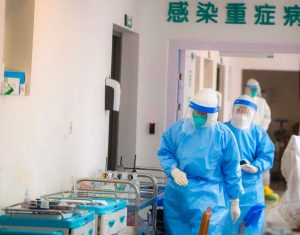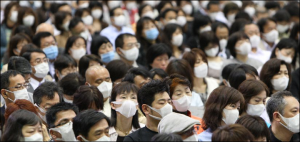 Myths around the risks of coronavirus in the UK are doing the rounds. We put the facts straight.
Myths around the risks of coronavirus in the UK are doing the rounds. We put the facts straight.
Face masks aren’t that useful.
You might be starting to see people wearing them in the UK, but there is limited evidence that they work. That’s because they are generally too loose, don’t cover the eyes and can’t be worn for long periods. Face masks need to be changed frequently (because they get sweaty), if they are to offer any real protection. To protect yourself, the World Health Organization (WHO) says it’s more important to:
cover your mouth and nose while sneezing, with a tissue or your elbow
put the tissue straight into a closed bin
wash your hands afterwards, and then frequently, with soap or sanitiser
keep your distance from people who are coughing and sneezing (at least one metre)
Don’t bother:
There is no evidence that your pet dog or cat can be infected with the new coronavirus, according to the WHO. But that doesn’t mean you shouldn’t regularly wash your hands with soap and water after touching them. Even cuddly pets can carry bacteria such as E.coli and salmonella – and these are bugs that can pass between pets and humans.
The new (and as yet unnamed) coronavirus is thought to have originated in a live animal market in Wuhan, China – with the source likely to be wildlife. The virus could have gone unnoticed in animals before jumping to humans, which is how many viruses start. eg. avian flu, Ebola, Sars. But that doesn’t mean animals in general are dangerous or spreaders.
Coronavirus: How worried should we be?
The new virus is part of the coronavirus family, which includes the common cold, Sars and Mers. It is seldom a ‘killer’. Most people will have mild symptoms (cough, high temperature) and will recover, the UK’s top doctor says.
However, the virus is making some people seriously ill (pneumonia, breathing problems) and killing a small number (severe lung issues) in China.
Remember that flu, which circulates every winter, kills people too – an average of 600 people die from complications of flu in the UK every year. Scientists still don’t know exactly how the new virus is spread. Tiny droplets from coughs and breathing are most likely. Getting a flu vaccine at the moment is still advised by UK health officials.
But there is no cure
There are no specific medicines or vaccines for the new virus, and antibiotics don’t work either (they fight off bacteria). Treatment options do exist but most people get better on their own. Scientists are working hard to develop a vaccine, but this will have to be tested in trials first, so it could be some time before it’s ready. Older people and those with other health conditions, such as asthma, heart disease, cancer and diabetes, are most vulnerable to the new virus. Although anyone of any age can get it, only a small proportion of people are dying from it.
Contact 111 or your local GP if you have concerns.
 Wuhan novel coronavirus and avian flu is a new strain of coronavirus first classified in Wuhan City, China. The pneumonia outbreak was initially reported in Wuhan City, central China’s Hubei Province, in December 2019 and experts have attributed the outbreak to a novel coronavirus that has since spread across China and abroad. The source of the outbreak has yet to be determined.
Wuhan novel coronavirus and avian flu is a new strain of coronavirus first classified in Wuhan City, China. The pneumonia outbreak was initially reported in Wuhan City, central China’s Hubei Province, in December 2019 and experts have attributed the outbreak to a novel coronavirus that has since spread across China and abroad. The source of the outbreak has yet to be determined.
Public Health England (PHE) is currently using the name Wuhan novel coronavirus (WN-CoV), in the absence of internationally accepted names for the virus and the disease/syndrome it causes. Other sources may use alternative temporary names for the virus, such as 2019 novel coronavirus (2019-nCoV). PHE will keep the terms used under review until such time as an internationally accepted term has been adopted.
Middle East respiratory syndrome coronavirus was first identified back in the mid 1960’s and previously called novel coronavirus.
The UK government is constantly monitoring the situation and collaborating closely with the World Health Organization (WHO) and the wider international community.
History of Wuhan novel coronavirus
On 31 December 2019, the World Health Organization (WHO) was informed of a cluster of cases of pneumonia of unknown cause detected in Wuhan City, Hubei Province, China.
On 12 January 2020 it was announced that a novel coronavirus had been identified in samples obtained from these cases and that initial analysis of virus genetic sequences have suggested this to be the cause of the outbreak.
What is a coronavirus?
A coronavirus is a type of virus and as a group, common worldwide. Some typical symptoms of coronavirus include fever and a cough that may progress to a severe pneumonia culminating in severe shortness of breath and breathing difficulties. Generally, coronavirus can cause more extreme symptoms in individuals with weakened immune systems, older people, and those with long-term conditions like diabetes, cancer and chronic lung disease, such as Chronic obstructive pulmonary disease (COPD)
How is it spread?
As WN-CoV has only been recently identified, there is limited information about the precise routes of transmission.
Therefore, current PHE guidance is based on knowledge gained from previous experience in responding to coronaviruses with significant epidemic potential such as Middle East Respiratory Syndrome Coronavirus (MERS-CoV) and Severe Acute Respiratory Syndrome Coronavirus (SARS-CoV).
It is known that both SARS-CoV and MERS-CoV can transmit via person to person and whilst yet confirmed for WN-CoV, it is a fair assumption that human-to-human transmission is possible.
Other coronaviruses have been found to be transmitted by large respiratory droplets and direct or indirect contact with infected secretions, blood, faeces and urine. Under certain circumstances, airborne transmission of other coronaviruses is also understood to have occurred via unprotected exposure to aerosols of respiratory secretions and sometimes faecal material.
Outbreaks of novel virus infections are always of public health concern. Risk from such outbreaks is reliant on the characteristics of the virus and includes how rapidly it spreads between people, the severity of subsequent illness and treatment or other measures which are available to control the impact of the virus, i.e. vaccination or medical treatment/medication options.
Infection control
As there are currently no effective drugs or a vaccine, control of this disease relies on the rapid identification, risk assessment, isolation of potential and actual cases, effective management and the investigation and follow up of close contacts to minimise potential onward transmission.
Effective infection prevention and control measures, including transmission-based precautions (airborne, droplet and contact precautions) with the recommended personal protective equipment (PPE) essential to minimise these risks but cannot eliminate it.
PHE state that coronaviruses have what is known as a ‘lipid envelope’ which means the outer envelope layer consisting of lipids, so a wide range of disinfectants are effective. Appropriate cleaning and decontamination of the environment is key in preventing the spread of this virus
PHE has classified WN-CoV infection as an airborne high consequence infectious disease (HCID) in the UK.
British scientists believe around 1,000,000 people worldwide are likely to become infected.
Symptoms of Wuhan novel coronavirus
Although most cases have been characterised by severe illness, there have been reports of a milder illness being detected. Based on current evidence, WN-CoV presents with flu-like symptoms including a fever, cough, or difficulty breathing.
NHS UK states symptoms usually include:
Those who have died in Wuhan appear to have had pre-existing health conditions.
Main principles
Actions to take at practice level
The Health Secretary has ordered a ‘belt and braces’ approach under recent plans to control spread of the virus in the UK. All 1500 people who have returned from Wuhan since mid-January have been asked to remain in isolation for at least two weeks after their return. If unable to do this, facilities will be set up to ensure safe quarantine. This is an added precaution as the WHO are unclear if the coronavirus is contagious during the incubation period.
If, despite this advice, an unwell patient presents at the surgery with a relevant travel history, this should be identified when they book in at reception and immediately placed in a room away from other patients and staff. The patient should remain in the room with the door closed and personal effects and any waste should also stay in the room. The patient should not be allowed to use communal toilet facilities.
Summary of action to date
PHE have now introduced advanced monitoring at airports with direct flights from China. A team of public health experts has been established at Heathrow airport to support and screen anyone travelling back from China who feels unwell.
Such hubs will comprise of rotational teams of 7 clinicians, working in shifts. This will be in addition to medical staff who are permanently in place at all UK airports and the advice issued to all UK airports for people travelling to and from China. The UK government has issued clinical guidance for the detection and diagnosis of Wuhan novel coronavirus, and infection prevention and control.
An alert from the Chief Medical Officer, Medical Director at PHE and Medical Director at NHSE have issued advice via a Central Alerting System (CAS) to alert to frontline staff and to increase awareness of the ongoing situation and any recommended actions.
Due to the incubation period, most individuals will develop symptoms after leaving the airport, therefore it is essential that UK residents and travellers are also kept abreast with the latest information to ensure they are aware of what to do if they experience symptoms.
NHS and PHE have established a plan of how to respond to someone who becomes unwell.
China has also introduced port-of-exit screening, so anyone found to be exhibiting symptoms will not be allowed to leave the country.
If and when a first case in the UK is confirmed, it will be announced as soon as possible by the Chief Medical Officer of the affected country. This will be followed by a statement by England’s Chief Medical Officer.
Resources
The main resources on the helpline are:
The FCO for travel advice:
https://www.gov.uk/foreign-travel-advice/china
NHS Choices
https://www.nhs.uk/
WHO World Health Organisation
https://www.who.int/
Contact us if you require further information.